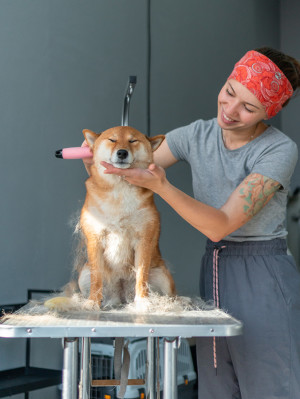For the Record, How to File Your Dog’s Papers
Don’t trust your dog’s important info to your foggy memory

Share Article
Unless you’re Marie Kondo, you’ve probably turned your house upside down on the hunt for your passport hours before a flight. So you can appreciate the value of a methodical filing system for your important documents. As a new pet parent, you’ll need one for your dog, too. Whether a Google doc or an old-school accordion folder is more your style, the key is to corral everything pertaining to your pup in one place in case of emergency (or just a staycation with a pet sitter). Not sure where to begin? Customisable pet care binders and printable wellness planners can be found on Etsy, Amazon and Pinterest. Now, the important part: what on earth goes into it?
Emergency contacts
In addition to spelling out every possible way to get ahold of you, also include the names and numbers of close friends or family members (give them a heads up) who can be trusted to help in a crisis in case you cannot be reached. This list should also include the contact information for your primary veterinarian, the nearest 24-hour service, and the Animal PoisonLineopens in new tab; as well as your trainer, dog walker and doggy daycare, if applicable. If there are any local facilities that you would prefer your dog sitter steer clear of, flag them as well.
Identification documents
This includes your dog’s adoption or pedigree paperwork, and animal health certificate, as well as their microchip number and GPS tracker information (ask your dog sitter to download the relevant app if necessary). Be sure to also file away a few photos of you and your dog so that if your dog is lost, you can instantly design a flyer; and if they’re stolen, you have proof of ownership. Other identifying features to catalogue include your dog’s age, breed mix, weight, coat colour, and any unique characteristics, such as a jowly overbite or eyebrows that rival Lily Collins.
Medical records
Pet owners rarely print out veterinary records these days, but the following information should be readily available: proof of your dog’s vaccination history, spay or neuter status, due dates for preventative flea and tick treatments, surgical history, health conditions, allergies, pet insurance policy forms, and any medications your dog is taking – including schedule, dosing instructions and tips for administering it (eg peanut butter).
Dietary instructions
Every pet sitter will want to know when, how often and how much you feed your dog. Be as specific as possible, noting any special instructions, such as if your ravenous pup requires the use of a slow feeder bowl. And don’t forget to mention their treat allowance.
Grooming needs
If yours is a low-maintenance dog where grooming is concerned, lucky you. It still couldn’t hurt to take note of the frequency of their baths and location of their shampoo, brush, ear flush, and other bits. If you’re a new parent to a polished Poodle or aristocratic Afghan Hound, you may need your groomer’s information on speed dial, or at the very least filed away somewhere.
House rules
It’s no secret that aunts and uncles are wont to spoil kids, so if you don’t want friends or family members bending the rules you’ve worked so hard to train your dog to obey, be upfront about what your dog is and isn’t allowed to do under your roof. Everything from the daily routines (toilet schedule) to the fine print (the couch is forbidden territory) applies.
Likes, dislikes and quirks
Kind of how coriander tastes like soap to you, your dog has their own oft-questionable preferences. It’s worth keeping a checklist of things they like (squeaky toys, your neighbour’s kids) and dislike (thunderstorms, men with beards), as well as any idiosyncratic quirks or habits, such as doing the zoomies at precisely 8pm.
You’ll see, an organised folder for your dog’s history to date is sure to spark joy – and be much appreciated by a dog sitter.

Katherine Tolford
Katherine Tolford writes about the pet industry and veterinary medicine. Her work, which has appeared on PetMD, Chewy, and Floof, has helped pet parents better understand their pets’ health. She’s also a pet parent to Milo, a loud-mouthed tuxedo cat, who likes to attempt backwards somersaults on the couch.
Related articles
![woman with new puppy]()
9 Unexpected To-Dos for New Pet Parents
Sound advice from seasoned dog and cat parents who have been there
![A senior Retriever/Terrier mixed breed dog shaking hands with its owner.]()
How to Teach an Old Dog New Tricks
Your senior dog might move slower these days, but that doesn’t mean they can’t learn new things
How Often Should You Groom Your Dog?
Just make sure you spell out ‘B-A-T-H’
![]()
All Aboard! How To Take Your Dog On A Train Journey
Heading on a UK break? Here’s how to help your pup (and you) survive that stressful train journey





